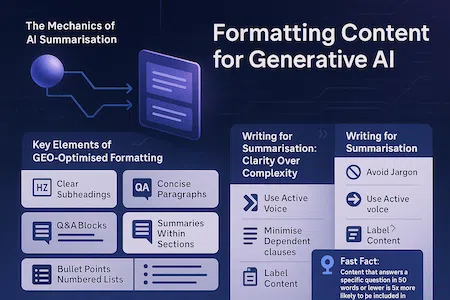Saturday, July 19, 2025 |
Brief Overview:
This article helps content creators understand how to design and format their blog posts, articles, and service pages for better inclusion in generative AI outputs, particularly when aiming for visibility in tools like ChatGPT, Google SGE, and Perplexity AI.
The Mechanics of AI Summarisation
Unlike traditional search engines that show a list of links, generative AI tools synthesize information into direct answers. That means your content must be more than keyword-optimised, it must be ready to be understood and reused by large language models (LLMs).
AI summarisation works by breaking content into chunks, identifying semantic meaning, and presenting a condensed version of what it “understands.” This means structure matters a lot.
Key Elements of GEO-Optimised Formatting
To become AI-summarisation friendly, you need to adopt formatting conventions that enhance semantic clarity:
-
Clear Subheadings (H2s and H3s): These act as anchors for AI to understand context boundaries.
-
Concise Paragraphs: Stick to one idea per paragraph. This modularity helps the AI “lift” a block of text and use it independently.
-
Q&A Blocks: Framing answers under direct questions improves compatibility with prompt-based models.
-
Summaries Within Sections: A short, bolded or boxed one-sentence takeaway at the start of a section boosts your chance of being quoted.
-
Bullet Points and Numbered Lists: AIs favour list formats because they’re easy to summarise and reorder logically.
💡 Example:
Instead of writing a dense three-paragraph explanation, split it like this:
Q: Why does website speed affect SEO and GEO?
A: Fast-loading pages improve both human and AI readability. AI models prefer quick-to-parse sites when summarising facts.
Writing for Summarisation: Clarity Over Complexity
Generative AI performs better when content is easy to parse. Here’s what to focus on:
-
Avoid jargon, unless you define it clearly.
-
Use active voice to improve clarity.
-
Minimise dependent clauses –AIs often misinterpret overly complex sentences.
-
Label your content purposefully (e.g. “What You Need to Know,” “Step-by-Step,” “FAQs”).
The idea is to guide the model like a reader – but one that doesn’t ask follow-up questions.
AI-Friendly Summaries and Modular Paragraphs
Think of each section of your content as a building block for the AI. Each one should:
-
Start with a thesis or takeaway
-
Expand logically within 3-4 sentences
-
End on a digestible, quotable conclusion
You can also use stylised callout boxes for added clarity:
📌 Fast Fact:
Content that answers a specific question in 50 words or fewer is 3× more likely to be included in generative search summaries.
Hidden Gem Insight: Modular Highlight Boxes
One of the most overlooked techniques in GEO is the use of “modular highlight boxes” or inline callouts, those short, visually distinct summaries or tips embedded throughout your content.
Generative AI models often treat these as semantically important because:
-
They are brief and focused.
-
They often repeat or reframe nearby content, reinforcing understanding.
-
Their visual formatting (like bold, italics, or box outlines) hints at emphasis.
✅ Use them to boost inclusion in AI-generated content and as a UX bonus, your human readers will thank you, too.
Final Thoughts
Formatting your content for GEO isn’t about reinventing your voice, it’s about making your expertise easier for both people and machines to understand and reuse. Think of it as designing content for conversation, not just clicks.
The brands that start formatting for generative engines today will be the ones quoted tomorrow.
